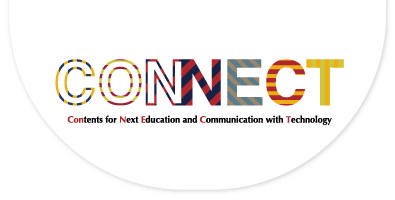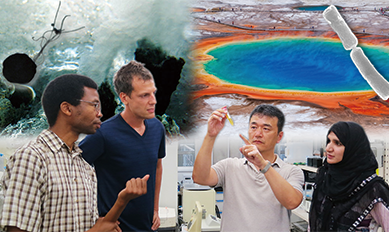TopicsTeacher Interview
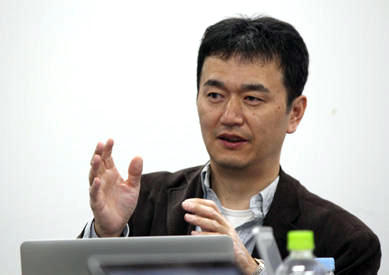
Running a MOOC and the Insights It Provides on Teaching Approaches
Professor Haruyuki Atomi, Graduate School of Engineering, Kyoto University
Professor Haruyuki Atomi's Massive Open Online Course (MOOC) "003x The Extremes of Life: Microbes and Their Diversity" was run online starting in November 2015, as part of efforts to share education on an international scale for the "Japan Gateway: Kyoto University Top Global Program," under the Top Global University Project. Looking back on the experience, Professor Atomi notes that the fact that a MOOC does not involve face-to-face teaching made it an opportunity to consider his approach to teaching.
Incorporating Aspects of Ongoing Research into the Course to Allow Participants to Vicariously Experience Research
How did you come to run this MOOC?
The six chemistry-related departments at the graduate school I belong to, the Graduate School of Engineering, provide "Top Global Courses" in chemistry. I was in charge of classes taught in English for that unit, so partly due to that, I was given the task of running a MOOC.
However, initially I didn't really have a grasp of what a MOOC is. At first I also had absolutely no idea of how the lecture materials were produced, and it wasn't until later that I found out how tough editing is, so I feel sorry for having caused a bit of trouble.
What kind of things did you cover in the lectures?
I covered my own research on extremophiles-that is, microorganisms that thrive in the most extreme environments. But I also touched on topics such as an overview of genomes, as I wanted participants to be able to learn a little about things like that. Rather than only communicating facts, I incorporated aspects of current ongoing research into the course to allow participants to vicariously experience research.
Striving to Ensure That Specialist Content Is As Easy to Visualize As Possible
How did you create the teaching materials for the MOOC?
In addition to the materials I had already used in lectures, about 70% of the course consisted of new materials made for the MOOC. I was concerned that if the course were to progress too rapidly, participants with relatively little knowledge of the field might have trouble keeping up, so I made sure that they could follow step-by-step. I also tried to ensure that any specialist content was as easy to visualize as possible, rather than just being a string of specialist terms. For instance, when I explained the stable structure of proteins, I tried to avoid using specialist terms as far as I could-the explanation went something like "the inside of the protein is greasy and does not mix easily with water, while the exterior surface interacts well with water."
MOOCs aren't just put online for the participants to simply watch. You also need to create questions to check their progress online. What kind of approaches did you take given that you would be marking online?
As this was my first time evaluating participants' progress on the basis of multiple-choice questions alone, I tried to incorporate several new approaches. The first was to include a number of questions related to biology, because I also adopted perspectives from the field of biology when putting together the course. On the other hand, I kept the number of problems about chemical formulae and other such aspects to a minimum. I also devised the questions such that even when the participant selected the wrong answer, it was possible to explain why it was wrong, so that they could learn from wrong answers too.
What would you say you have gained from creating the MOOC lectures?
At first, I used animation footage of a chameleon to give explanations. But at the time, as it was all completely new to me, I had absolutely no idea how it would be made. And yet in the process of creating the MOOC, I was able to grasp an image of what kinds of things might be possible to do. I initially suggested going to a hot spring and filming the archaea in there, but I didn't have any idea of how we would actually do that. Now, however, I know what kinds of equipment we would need to take with us to the location and what kinds of materials we can create if we do so. The next time I have a topic to cover, I will be able to roughly sense how we can present it effectively as well as aspects that are doable and areas that might be a little difficult. It was highly worthwhile learning that.
Comments on the Discussion Forum Provide Feedback on Lectures
What were your impressions once the MOOC actually started?
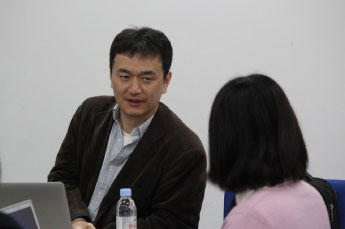
I checked the discussion forum a lot. It struck me that there are a lot of keen, proactive people out there-especially because I'm not really that proactive myself! But as I read the discussion forum comments, I realized midway through the course that all too many people were misunderstanding the same things. The discussion forum comments became feedback on my lectures. It makes you think about how such misunderstandings could happen. That was a positive aspect. I think that's something that anyone would be able to experience, whichever subject they are teaching.
Did you run the discussion forum?
In practice, I responded to the questions on the discussion forum along with two students who are my teaching assistants (TAs). I also discussed various aspects of my responses with the TAs before posting them.
It looks like you received a lot of comments in the fourth week.
Judging from the discussion forum, about 5 to 10% of the participants had an extremely high level of knowledge. These were participants with knowledge far more advanced than that of the students at our graduate school. I included cutting-edge information on genomes in the fourth and final class, and I think this struck home with those participants. I put that explanation together at the end of the course, because I think that it's natural that a rather advanced topic might confuse people new to the field.
Having actually run the course, what do you think of four weeks as the length for a MOOC?
Reading the responses to the questionnaire that participants completed after the course, there was some criticism that while I was covering the topic of extremophiles, I hadn't given a systematic introduction to the relationships between specific environments and the characteristics of the genes of the microorganisms that inhabit such environments. For this course I was too focused on making the explanations clear-I think I should have given a little thought to which metabolic pathways I should cover. If I did so, I would definitely need another week on genomes. I'd also like to add a bit more on areas like finding archaea from Japanese hot springs, which I didn't get to cover this time, and to enhance the experiments we showed. With all that included, I think the course could easily be about another three weeks longer.
Simple Explanations Ensure Better Understanding
After your experience of making and running a MOOC, what aspects made you feel glad to have done it, if any?
It makes you think about your approach to teaching. When I was making the teaching materials for the MOOC, I gave a lot of thought, from a number of perspectives, to my choices on what would be the best way to teach certain aspects. I don't think I had given so much thought to my approaches when preparing the lectures I taught face-to-face. In that sense, it was a really helpful learning experience.
Do you think there will be any changes to the way you give lectures in the future?
Yes, there will definitely be changes! Because running the MOOC allowed me to realize things like where to start with a topic to make it easy to understand. I think I will also make changes to how I give explanations and put together the content. I'm starting a course here at Kyoto University for students in the first year of the master's program, and I think that what I've realized about the part on genomes will be useful for that. And whereas up until now my explanations-such as how I described the structure of proteins or flow diagrams-were more complicated, I made them considerably simpler in this MOOC. I've realized that such simple explanations like I used in the MOOC ensure that students pick up a better understanding.
Are there any other aspects you will be able to draw on from this experience in your lectures?
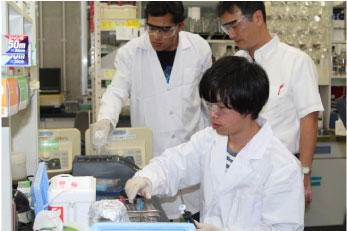
For this course, we conducted and filmed experiments based on what was explained in the lecture. I don't do experiments in my regular lectures. But I think that showing an experiment helps students to get a real feeling for what has been taught and makes things very easy to understand. The experiments in the MOOC course didn't really yield the results we were looking for, so I think that if we had made footage that was a little easier to understand, I would have used it in my classes here at the university. It's a little difficult to do experiments in the lecture hall, so I think that if we conducted them in the laboratory and filmed them like we did for the MOOC, we could use that footage in regular lectures too. In that sense, I think the scope of my regular lectures has expanded.
And when I was making the teaching materials for this MOOC, I also received various photos of microorganisms from other researchers. Until then I hadn't used images of actual microorganisms in my classes, but I think I will use plenty of those kinds of images in my future lectures too.
Questions asked by: Masako Okamoto, Hiroyuki Sakai, Mana Taguchi, and Yoshimi Kozai
Article composition: Motoko Okumoto
Click here to get more information on KyotoUx.
